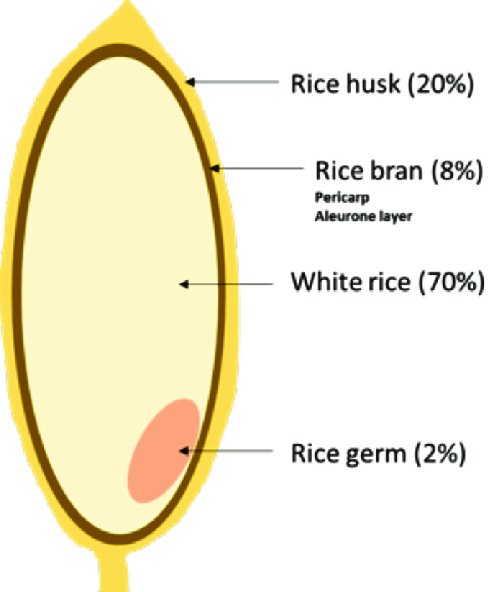Introduction
Rice(Oryza sativa L.) belongs to the genus Oryza, family Poaceae. It is a staple food for half of the world’s population. Consumption of rice provides one fifth of calories. It is the second-leading crop in production. Globally, 645 metric tons of rice were produced, and 90% of production is done by Asian farmers. 1
Rice is believed to have originated at least 130 million years ago as wild grass. Rice cultivation was first practiced about 10,000 years ago in India. The rice is grown all over the world except Antarctica. The cultivation of rice is dependent on high rainfall and requires water. Subsequently, it is grown anywhere, including hills, as well as on plain lands. It is also suited to countries with low labor costs. The rice comes in varied colors, shapes, and sizes, such as long, medium, and short grains. India is the second-largest producer and exporter of rice in the world. There are more than 1,10,000 varieties of rice. Rice was named based on color, shape, appearance, aroma, color, season, numbers(indicating the time to grow), places, and traits. Some traits are alkaline-tolerant, drought-tolerant, and flood-tolerant; they grow easily and cheaply, and some are deeply rooted. 2
History of Rice
Rice classification and domestication
The two primary domesticated species are Oryza sativa(Asian rice) and Oryza glaberrima(African rice). Each has its own domestication history, with O. sativa originating from wild Oryza rufipogon in Asia and O. glaberrima being derived from Oryza barthii in West Africa.
Wild relatives and species complexes
The genus Oryza includes 21 wild relatives and is classified into four species complexes:
O. sativa complex: includes domesticated O. sativa and O. glaberrima and wild species such as O. rufipogon, O. nivara, O. barthii, O. longistaminata, O. meridionalis, and O. glumaepatula. O. sativa is grown all over the world, and O. glaberrima is seen in West Africa.
O. officinalis complex: Includes wild species like O. officinalis, O. nivara, and O. glaberrima.
O. ridelyi complex: comprises species like O. ridelyi, O. granulata, and O. nivara.
O. granulata complex: contains species like O. granulata and O. ridelyi.
Geographical distribution
Oryza sativa: widely distributed, with high concentrations in Asia.
Oryza glaberrima: Grown predominantly in West Africa.
Oryza rufipogon: Found across Asia and Oceania.
Oryza barthii: Endemic to West Africa.
Oryza longistaminata: Found throughout Africa.
Oryza meridionalis: Native to Australia.
Oryza glumaepatula: Endemic to Central and South America.
Domestication and ancestral pools
Oryza sativa: domesticated from Oryza rufipogon, with ongoing debates whether O. nivara(an annual form) or both forms were involved.
Oryza glaberrima: domesticated from Oryza barthii.
The domestication of rice is a testament to its significance as a staple food crop, with its origins rooted deeply in both Asian and African agricultural history. Understanding the wild relatives and their geographical distributions helps elucidate the evolutionary processes and human selection that have shaped modern rice varieties.3 The nutritional profile of rice varies depending on color, such as white, brown, red, and purple. The rice grain(Figure 1) has many parts; they are the hull/husk, endosperm, bran, and embryo. The husk protects and has cellulose and silica. Under the husk, Bran is located, which supports the pericarp, seed coat, and aleurone layer with protein, oil, vitamins, and minerals; these layers are low in starch. The embryo located at the bottom of the grain has protein and minerals. The central part, endosperm, contains carbohydrates and a low portion of protein, fat, and minerals. During the processing of rice, the husk and bran layers are removed. 4
Nutritional properties of rice
Rice is classified as either white(refined or polished) or brown(unpolished). The difference arises after the milling process. In the past, before the advent and intervention of technology, rice was consumed after hand pounding, which has germ constituents and bran. Technological intervention modified the consumption pattern from unpolished rice to polished rice. During this process, nutrients are lost, resulting in the prevalence of diabetes, hypertension, arthritis, cancer, and cardiovascular disease. Polished rice is devoid of germs and bran and has starchy endosperm. 5
Brown rice is a source of dietary fiber, calcium, zinc, selenium, phosphorus, magnesium, iron, manganese, protein, B complex vitamin(niacin, thiamine, riboflavin), and bioactive compounds such as tocols(α-tocopherols and α-tocotrienols)(ß sitosterol), phenolic acids, flavonoids(apiginine), and oryzanol (24-Methylenecylcoartanyl transferulate). It is rich in carbohydrate, fat, protein, calcium, magnesium, iron, zinc, manganese, and phosphorus. The grain is predominant in starch, ranging from 75-80%. Amylose and amylopectin constitute 12% of water and 7% of protein. Pigmented rice has anti-inflammatory properties, is anti-diabetic, prevents cardiovascular problems, and inhibits tumor formation. They contain phenolic acids, anthocyanins, antioxidants, vitamins, phytates, tocopherols, and carotenoids. These healthy nutrients are present in the rice kernel, and the polishing process removes the nutrients. 6
Currently, the white rice is consumed by the population due to its palatability, ease of cooking, and shelf life. It has a high glucose load. During milling of rice, loss of phytonutrients and dietary fibers is noted.7 A study conducted by Mohan et al.8 revealed that polished rice intake is related to metabolic syndrome, insulin resistance, and type 2 diabetes.
Conclusion
The Indian population is dependent on rice, and consumption of traditional rice will help to alleviate the disease condition. Value-added products can be prepared by incorporating traditional rice in various snack preparations. The pigmented rice is a source of macro- and micronutrients. Thus, negligence of medicinal properties of traditional rice paved the way for diseases, and the change in consumption pattern from polished rice to unpolished rice will bring a significant change in the health of the population.

